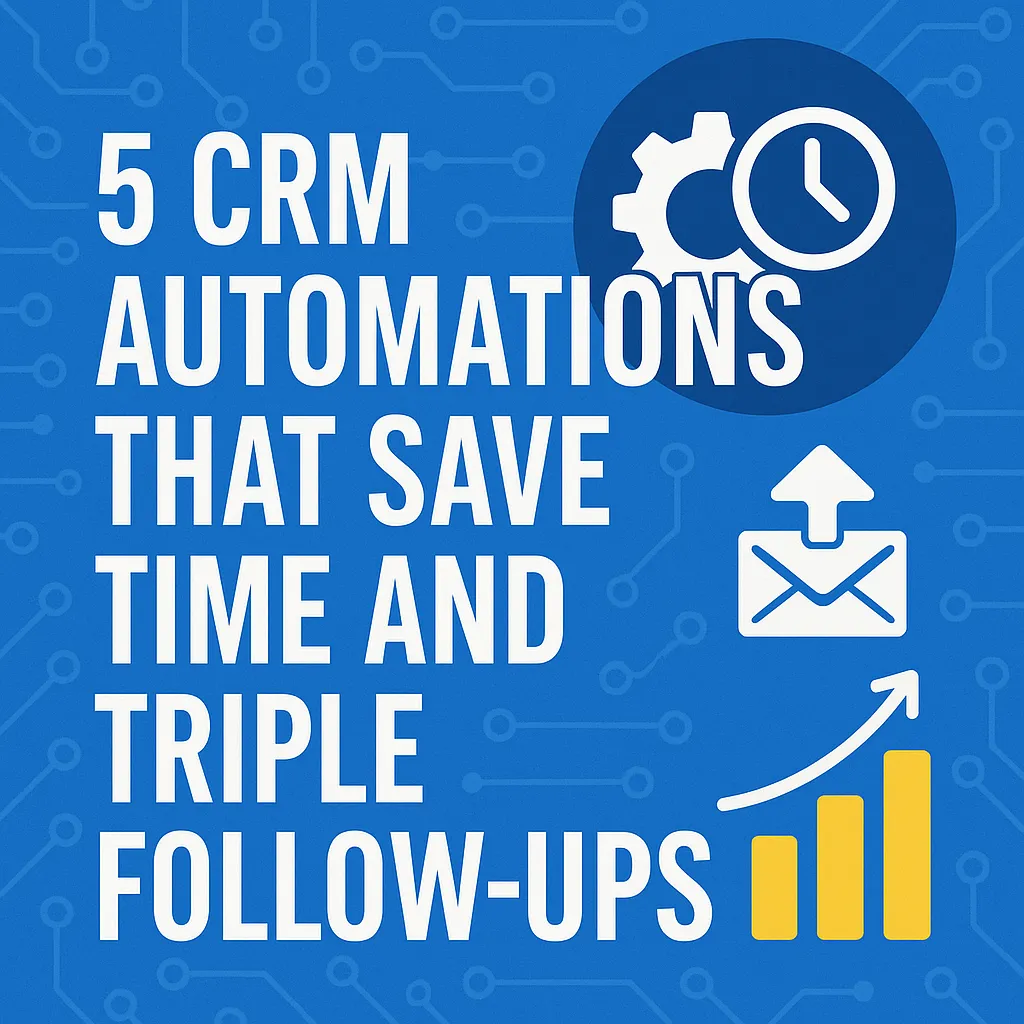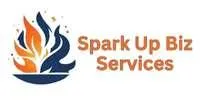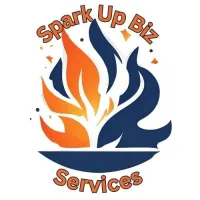Our Latest Articles

5 CRM Automations That Save Time and Triple Follow-Ups
Why Automate Your CRM?
Imagine a world where every lead you attract gets nurtured intelligently, where no reply, no click, and no missed meeting becomes a silent opportunity cost. That’s not fantasy—it’s what happens when you layer high-leverage CRM automations under your sales and marketing processes.
Modern buyers expect responsiveness, context, and relevance. Manually juggling outreach, enrichment, score-based prioritization, and feedback is inefficient and inconsistent. High-performing teams don’t just follow up—they follow through. The right automations save 5–10 hours per week per employee, eliminate human error in sequencing, and—critically—triple the number of meaningful touchpoints with prospects. That’s the difference between a lead slipping into a cold grave and turning into a deal.
This article dives deep into five CRM automations that together create a follow-up ecosystem so reliable it feels like having an extra (very organized) sales ops person on the team. You'll get:
What to automate
Why each automation matters
How to implement it (step-by-step)
Metrics that prove ROI
Real-world mini case studies
Advanced tweaks for scaling
Whether you’re on Salesforce, HubSpot, Zoho, PipeDrive, or any modern CRM, this roadmap gives you the power to save time, reduce friction, and triple your follow-ups—without turning your team into automation engineers.
Automated Lead Capture & Enrichment
The Challenge
Leads come from a dozen sources: web forms, chat widgets, social DMs, referral emails, offline events uploaded manually, and more. Manually funneling each into your CRM, de-duping, and tagging them wastes hours and introduces errors. Sales reps often start outreach with zero context—no firmographic insight, no understanding of buyer stage, no awareness of prior touchpoints. That’s cold outreach in a warm world.
The Automation
An automated lead capture and enrichment pipeline does the heavy lifting immediately:
Automatically creates/updates contact and account records when a lead comes in.
Enriches those records in real time with firmographics (company size, industry), professional data (role, seniority), and behavioral signals using third-party enrichment tools like Clearbit, ZoomInfo, or native integrations.
Tags/segments leads by source, campaign, intent, and persona, enabling follow-up sequences tailored to how they entered your world.
Deduplicates to keep the database clean and prevent outreach mishaps.

Implementation Steps
Inventory Lead Sources: List every inbound lead channel—web forms, chat, LinkedIn ads, referral forms, manual uploads, etc.
Connect Integrations: Use native CRM connectors or middleware (Zapier, Make, custom APIs) to funnel each source into the CRM in real time.
Enrichment Setup: Plug in enrichment providers. Configure which enrichment data fields you want (industry, team size, tech stack, role).
Deduplication Rules: Set rules around matching logic (email, company+name, phone) and automations to merge or flag duplicates.
Tag & Segment: Create consistent tags like
Inbound_Whitepaper,Paid_Social_MQL,Referral_SMB, etc. Populate custom fields if needed.Validation & Testing: Ingest test leads from each source. Verify creation, enrichment accuracy, tag assignment, and deduplication behavior.
Auto-trigger Follow-up: Tie in the next automation—drip sequence or assignment—based on lead characteristics.
Advanced Tactics
Progressive Profiling: Instead of asking for everything upfront, incrementally request missing information during later touchpoints, feeding back to the CRM.
Intent Signal Layering: Augment firmographic enrichment with behavioral intent data (e.g., content consumed, pages visited) to refine lead quality.
Auto-qualification via Rules: Use enriched data + behavior to flag “sales-ready” leads automatically.
Common Pitfalls & How to Avoid Them
Over-enrichment Delays: If enrichment calls slow down lead availability, use asynchronous enrichment—create the record instantly, then backfill details.
Tag Sprawl: Too many tags without a naming convention cause chaos. Audit quarterly and retire obsolete ones.
Bad Data from Sources: Validate inbound data and set guardrails (e.g., discard leads without emails or with disposable domains).
Metrics to Track
Time saved on manual entry (hours/week per rep)
% of leads enriched within X minutes of creation
% of leads correctly tagged/segmented
% of enriched leads entering nurture/follow-up
Conversion lift (e.g., qualified lead rate before vs. after enrichment)
Mini Case Study
TechScale had reps manually copy leads from their whitepaper downloads into the CRM. After deploying automated capture + enrichment, they cut lead processing time in half, increased contextual outreach, and saw a 30% higher qualified follow-up rate. Reps spent their time selling instead of admin’ing.
Drip Email Sequences with Behavioral Triggers
The Challenge
Single-send outreach is a one-hit-wonder. Without consistent follow-up, prospects go dark. Manually keeping track of who opened, clicked, or replied is error-prone, and generic sequences feel robotic.
The Automation
Behaviorally triggered drip campaigns dynamically adapt based on what a prospect does (or doesn’t do), ensuring relevance and persistence without manual babysitting:
Trigger-based sends: If a prospect doesn’t click, send a reminder. If they click a case study link, send a deeper success story.
Pause logic: Stop the sequence if a meeting is booked, the lead replies, or the lead is disqualified.
Personalization: Merge fields (name, company, pain point) and conditional content based on segmentation data.
Branching paths: Different follow-ups depending on behavior: opens but no click vs. clicks vs. no engagement.

Implementation Steps
Define Objectives: Awareness? Demo bookings? MQL → SQL? Align sequence length with intent.
Map the Journey: Outline paths based on behaviors (e.g., Opened no click → gentle nudge; Clicked pricing → social proof + case study).
Write the Emails: 3–7 emails with clear CTAs, value nuggets, and micro-commitments. Vary tone; mix utility with credibility.
Build in CRM: Use workflow engines to structure triggers and timing.
Set Behavioral Triggers: Opens, clicks, replies, site visits, form submissions, or lead score thresholds.
Include Smart Delays: Avoid blasting too fast—3 days between non-response nudges, immediate follow-up upon high-intent signals.
Add Exit Conditions: Sales rep reply, meeting scheduled, conversion event triggers sequence stop.
Test & Iterate: A/B subject lines, preview text, send windows, and CTA wording.
Personalization at Scale
Merge tags for names, company names, prior content consumed.
Conditional blocks: “Since you checked out the pricing page…” or “Because you downloaded our guide on X…”
Use tokens to reflect industry or pain point without manual editing.
Testing & Iteration
Subject line testing: Run multivariate tests for open optimization.
Time-of-day experimentation: Adjust send times for prospect geographies or behavior patterns.
Content sequencing tweaks: Swap email order if click-through drops at a certain step.
Metrics to Track
Open rate (baseline expectation: 20–40%)
Click-through rate
Reply rate (typically 3x higher than single emails if triggered well)
Conversion rate (MQL → SQL, demo booked)
Unsubscribe rate (indicator of over-mailing or mis-targeting)
Sequence dropout points (where prospects stop engaging)
Mini Case Study
A 500-rep sales organization layered behavioral drip sequences into their outbound cadences. Response volume exploded—150% more replies—and follow-ups tripled, turning previously cold prospects into engaged conversations.
Task Reminders & Escalations for Timely Follow-Ups
The Challenge
Even with leads captured and sequences deployed, human moments still matter: calls, personalized check-ins, or recovery of stalled deals. When reps drop the ball—missed demos, forgotten callback windows, or unreturned emails—momentum dies. Managers often don’t know until it's too late.
The Automation
Task-based automations ensure nothing slips:
Auto-create follow-up tasks based on triggers (no-show on call, lead inactivity, deal stage stagnation).
Escalation rules: If a follow-up task isn’t completed in a defined window, alert managers, reassign, or bump priority.
Multi-channel reminders: Push tasks into email, Slack/Teams, mobile, or CRM dashboards.
High-value account flags: Instant alerts when specific accounts need attention or go quiet.
Implementation Steps
Define Trigger Events: Call no-shows, unreturned proposals, stalled deals over X days, negative feedback, etc.
Create Task Templates: Pre-populate task titles, descriptions, and expected outcomes to reduce friction for reps.
Automate Task Generation: Build workflows that spin up tasks automatically with due dates and ownership.
Design Escalation Paths: Example:
Day 1 overdue → Email reminder to rep
Day 2 overdue → Slack ping + note to sales manager
Day 3 overdue → Auto-reassign or leadership alert
Integrate with Collaboration Tools: Tie into Slack/Teams for real-time visibility.
Visibility Dashboards: Build manager views showing overdue, upcoming, and escalated tasks.
Training & Accountability: Ensure reps know what auto-generated tasks mean and how to act.
Escalation Strategy Design
Severity-tiering: Not all misses are equal. Stale cold lead follow-ups vs. enterprise demo no-shows get different escalation urgency.
Time-based thresholds: Avoid immediate panic; allow reasonable time before escalation but keep the window tight enough to preserve momentum.
Owner fallback: If the assigned rep is unavailable (vacation, sick), define automatic secondary owners to keep flow alive.
Metrics to Track
Task completion rate (goal: >95% on high-priority tasks)
Average follow-up lag time after trigger
Overdue escalation volume
Reduction in stalled deals
Cold-lead churn improvement
Mini Case Study
Acme Corp implemented task automations for demo no-shows and unreplied proposals. The result: an 18% drop in cold-lead churn in the first quarter, and managers had real-time clarity into where pipeline velocity was draining.
Lead Scoring & Intelligent Routing
The Challenge
Without prioritization, your team treats all leads like equals—bad idea. High-intent, high-fit prospects get buried under low-effort, low-interest noise. Manual triage introduces delays and inconsistencies.
The Automation
Lead scoring + intelligent routing ensures the right lead is in the right hands at the right time:
Score leads based on a combination of behavior (page views, content consumed), demographics/firmographics (role, company size), and engagement velocity.
Grade leads (A/B/C or numeric tiers) and apply business logic—A leads get immediate senior rep attention.
Automatically route qualified leads to the appropriate rep based on score, territory, industry, or capacity.
Instant alerts when a lead crosses a threshold, prompting immediate outreach.
Implementation Steps
Define Your ICP (Ideal Customer Profile): Sketch out attributes of high-value customers—industry, revenue range, job titles, behavior patterns.
Build Scoring Model: Assign points for actions and attributes (e.g., webinar attendance +10, pricing page view +15, job title match +5).
Automate Field Updates: Use workflows to increment score fields dynamically as interactions occur.
Set Thresholds: Determine what score constitutes “sales-ready.”
Routing Rules: Map high-score leads to the right reps (seniority, territory, language, etc.).
Alerting Logic: Push notifications for immediate follow-up when critical scores are reached.
Review & Refine Monthly: Shift point values based on what correlates with actual closed business.
Dynamic Scoring Enhancements
Decay logic: Reduce score over time if a lead goes cold, keeping pipeline hygiene.
Score multipliers: Boost scores for preferred industries or strategic accounts.
Behavioral velocity: Factor in how fast a lead accumulates points—fast movers often deserve higher urgency.
Metrics to Track
% of high-score leads contacted within a target window (e.g., 5 minutes)
Win rate comparison (A vs. B vs. C leads)
Sales cycle length by lead grade
Conversion lift from routed leads
Scoring model accuracy (alignment between score and eventual outcome)
Mini Case Study
Companies using advanced lead scoring see up to a 300% lift in conversions on qualified leads, effectively tripling follow-up effectiveness for high-fit prospects. When “A” leads hit a qualifying score threshold, they were contacted within five minutes 80% of the time—leading to shorter cycles and higher close rates.
Feedback & Survey Automations for Continuous Improvement
The Challenge
Post-sale intelligence—NPS, customer satisfaction, qualitative feedback—is often an afterthought, manually chased, and poorly acted upon. Without systematic capture and response, you miss red flags and testimonials.
The Automation
CRM-driven feedback loops automatically:
Trigger surveys (NPS, satisfaction, onboarding experience) after defined events (e.g., 7 days post-delivery, 30 days after launch).
Capture responses and write them back to the CRM record.
Route low scores to customer success for immediate intervention.
Capture high scores for testimonials, referrals, or case study outreach.
Tag and segment feedback by product, rep, geography, etc.
Implementation Steps
Design Short Surveys: Keep it mobile-friendly—one key metric (e.g., NPS) + optional comment field.
Pick Tools: Use CRM-native survey modules.
Integrate with CRM: Sync responses automatically; map fields (score, comments, metadata) into customer records.
Trigger Logic: Set automation to send surveys based on “Closed Won” date, project completion, or onboarding milestone.
Feedback Workflow:
Low scores (<6): Immediate alert to customer success + scheduled outreach task.
Mid scores (7–8): Passive monitoring; consider follow-up for clarification.
High scores (9–10): Ask for testimonials/referrals and promote internally.
Closed Loop: Log outreach after negative feedback and track resolution.
Public Proof: With permission, feed positive responses to review widgets, case study pipelines, or social proof sequences.
Turning Feedback into Action
Feedback dashboards: Score trends by cohort, rep, product.
Root cause analysis: Use qualitative comments to surface systemic issues.
Customer health scoring: Combine feedback with usage, support tickets, and renewal likelihood.
Metrics to Track
Survey response rate (automations with reminders can boost +40%)
Net promoter score (trend over time)
Time to resolution on low-score alerts
Customer retention / churn changes post-feedback loop implementation
Number of testimonials/referrals generated automatically
Mini Case Study
OptiServe’s automated NPS workflow flagged unhappy customers within hours. Proactive outreach reduced churn by 12% over six months, while promoters were fast-tracked into referral campaigns, reducing acquisition costs.
Layering Automations: Building the Follow-Up Ecosystem
Individually, each automation saves time. Together, they form a follow-up web that’s resilient, responsive, and revenue-generating.
Flow example:
Lead captured & enriched.
Behavioral drip sequence begins based on lead source.
Lead scoring updates as prospect engages.
High-score triggers an alert and intelligent routing to a senior rep.
Task automation creates a personalized follow-up for the rep if the prospect goes quiet.
Closed-won event triggers a feedback survey, feeding insights back into the system.
Positive feedback feeds into testimonials pipeline; negative feedback spins up a customer success intervention.
This layered approach ensures no gaps—from awareness to advocacy—and maintains triple the meaningful follow-ups without overwhelming any single team member.
Best Practices & Getting Started
Audit first. Map existing manual touchpoints before automating junk.
Start small. Pick one automation (e.g., lead enrichment) and flesh it out end-to-end.
Use consistent naming conventions for tags, scores, and sequences to avoid confusion.
Train the team. Automation only works if humans understand what’s happening and why it matters.
Measure everything. Dashboards should reflect both activity (tasks created, emails sent) and outcome (response rate, conversion lift).
Review quarterly. Lead scoring drift, sequence fatigue, and enrichment relevance change—keep tuning.
Humanize when needed. Automations should augment, not replace, empathy. Always include a human-checkpoint for high-value movements.
FAQ
Q: Will automations make outreach feel robotic?
A: Only if you let them. Personalize content, use conditional logic, and mix in human touches. Automations handle the grunt work; your reps still have the conversations.
Q: How many drip emails are too many?
A: Quality over quantity. A well-designed 3–7 step sequence with behavior branching and smart exit conditions usually hits the sweet spot. Monitor fatigue via engagement drop-offs and unsubscribes.
Q: What if my lead scoring model is wrong?
A: That’s expected early. Treat it as a living model—compare score tiers to actual outcomes monthly and adjust point values, thresholds, or decay logic.
Q: Do I need all five automations to see benefit?
A: No—each standalone drives value. But layering them multiplies impact. Start where your biggest bottleneck is and build out.
Q: How do I prevent prospects from feeling spammed?
A: Use intelligent pause logic, frequency caps, and behavioral filters. If someone replies, books a call, or disqualifies, the sequence should stop immediately.
Quick Start Checklist
Audit current lead sources and follow-up gaps
Set up automated lead capture & real-time enrichment
Build first behavioral drip sequence with at least 3 emails
Define lead scoring model and apply basic thresholds
Automate task creation for missed or stalled actions
Implement feedback/survey trigger post-success event
Create routing logic for high-score leads
Build dashboards for visibility (tasks, score performance, survey results)
Train team on reading and acting on automation signals
Schedule quarterly review to optimize
Final Thoughts
Automation isn’t a replacement for people—it’s a superpower that lets your team do the high-value work while systems handle the repetitive, the timely, and the consistent. By implementing these five powerful CRM automations, you not only reclaim hours and reduce friction—you build a follow-up engine that triples touchpoints, surfaces the right opportunities, and keeps customer relationships moving forward.
Start with one, layer the next, and watch how the compound effect turns chaotic outreach into predictable pipeline growth. Ready to stop chasing and start converting? Your CRM is about to become your best teammate.


